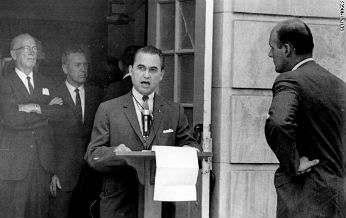RACE: Real Change Is Possible!
By Neil Earle
 One of my favorite titles from my own library hits the nail on the head.
One of my favorite titles from my own library hits the nail on the head.Just back from a family trip to Eastern Canada I was surprised by a sincere question from a knowledgeable, fairly astute older cousin. “Neil,” he asked me on his front porch on a hot July day, “Has the South changed at all?” Having just moved to the South last November I had no hesitation answering with a hearty “Oh, my, YES!”
That made me think: What are people thinking about in other countries when they see the grisly clips of apparent racial discord endlessly replayed on the nightly news. Every even remotely-racially tinged incident that comes screaming out of the American news media these days usually calls for a now-hackeneyed expression “let’s start a dialogue about race.” Starbucks tried it a few years ago and it crashed and burned and they themselves were implicated in a situation less than a year ago.
The New Multi-Colored America
“Race,” author Studs Terkel once wrote, “is the American obsession.”
That observation may need revision in the face of very recent changes. Historian and statistican Philip Jenkins reported in 2007: “America is steadily moving from a back-and-white affair to a multicolored reality.” The two largest states – California and Texas – are already “majority-minority” areas where no ethnicity has a majority (The Next Christendom, page 117).
This may make things even more complicated in the future but in the midst of repeated and even tiresome media calls for “a conversation about race” some may ask, Is change even possible?
Well, there is more than a little inspiration in remembering how far the country has come.
 Governor Wallace apparently – and reamarkably – came to see real change was possible.
Governor Wallace apparently – and reamarkably – came to see real change was possible.The Wallaces Weigh In
A black intellectual named Barack Hussein Obama was elected to the Presidency not once but twice. After that first memorable occasion there was a startling comment by Peggy Wallace Kennedy on CNN. Mrs. Kennedy is the daughter of George Wallace, the well-known governor of Alabama who famously “stood in the doorway” impeding the passage of two black students to the University of Alabama in 1963. That picture has become part of the pantheon of the Civil Rights struggle, even if the governor was clearly grandstanding and walked away quietly when he had made his protest.
The subject of a PBS documentary in 2000, Wallace was supposed to have changed his mind greatly on matters of race in later years (Life: Century of Change, page 229). Governor Wallace received 10,000,000 votes for President in 1968 on an anti-integration platform and was wounded in the election of 1972 by a would-be assassin. He was confined to a wheelchair until his death in 1998. After a third failed Presidential bid in 1976, he slowly disappeared from the national spotlight remembered mostly for his “Stand in the Schoolhouse Door.” Bob Dylan alluded to this in his 1960s song “The Times They Are 'a Changin” which sang in part:
“Come Senators, Congressmen please heed the call,
Don’t stand in the doorways don’t block up the hall.”
Then, screaming at us in the midst of our often unstructured newscasts at too fast a speed came Peggy Wallace Kennedy’s timely remembrance. She registered the opinion that there would be “a substantial chance” that her father would, like her, vote for Barack Obama. She admitted to being “mesmerized” by Obama’s speech in 2004 at the Democratic National Convention.
“The World Does Move”
If Mrs. Kennedy is right, her commentary is a seminal moment for Americans. She provides eyewitness testimony for the governor who once vociferously proclaimed, “Segregation now! Segregation forever!” making real changes. Mrs. Kennedy wrote: “My father lived long enough to come to an understanding of the injustices borne by his deeds and the legacy of suffering that they left behind.” Her father became a born-again Christian in the late 1970s and his 1983-1987 term as governor was marked by a record number of black appointments to high office.
Mrs. Kennedy testified that the governor who listened to “reports of brutality” streaming into the Governor’s mansion from Selma, Alabama in 1965 was “not the same man” later in life. She recalls him as the wheelchair-bound leader who later on “rolled through a sea of African-American men, women and children who gathered with him to welcome another generation of marchers,” this time reenacting “in honor and remembrance” the route from Selma to Montgomery.
For those of us who lived through those tumultuous days, Peggy Kennedy’s remarks are historic, even sublime. We need to remember the journey ex-Governor George Wallace apparently made in his own mind on the subject of race. Let’s savor these moments. No need for a conversation as much as kindly remembrance.
Abolitionist senator Sumner from Massachusetts said after Lincoln signed the Emancipation Proclamation of 1863, “So, the world does move.”
It does. It does indeed. Let’s all remember that when we think the world can’t change.